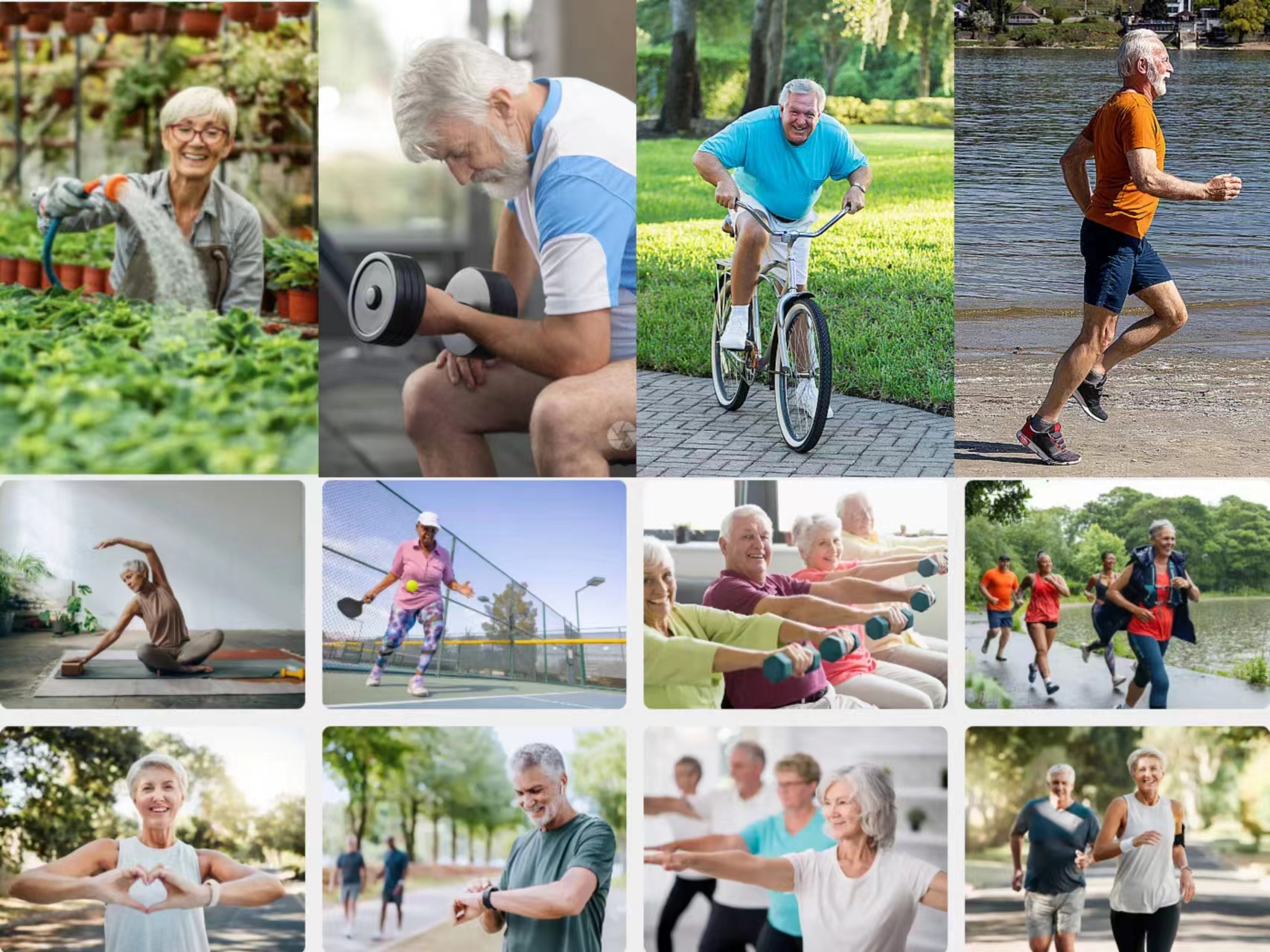
Originated from Voltaire, the French Enlightenment thinker, "life lies in movement " has nowadays become a household motto throughout the world. IWLA emphasizes that the combination of "life lies in exercise" and "exercise requires science" and the complementarity of science-based exercise and enjoyable labor in promoting wellness and longevity.
Science-Based Exercise
1. Types of exercise
· Aerobic exercise is usually low-intensity and slow-paced exercise that can last more than 30 minutes without causing short breath and heart racing. Examples are walking, jogging, swimming, cycling, dancing, aerobics, table tennis, badminton.
· Strength or resistance training activates muscles through resistance generated either by external gravity such as dumbbells, shot put, and fixed fitness equipment or by body weight via self-weight movements such as squats, push-ups, and pull-ups.
· Flexibility training enhances the body's flexibility, balance, and coordination, exemplified by stretching, squats, yoga, Tai Chi, and Pilates.
· Comprehensive exercise includes individualized workouts that combine the three types of exercises or a particular aerobic exercise that can simultaneously enhance strength and flexibility, such as swimming, dance, and Tai Chi.
2. Health benefits
· Aerobic exercise can help improve cardiopulmonary function, enhance metabolism, cardiovascular, immune health and improve insulin sensitivity, and reduce the risk of cardiovascular disease and diabetes.
· Strength training can increase muscle strength, improve bone density, reduce the risk of fractures due to osteoporosis. increase metabolism, help control weight, and reduce fat accumulation. Proper training techniques are required to avoid injuries.
· Flexibility training can help improve posture, reduce the risk of injury, reduce joint and back pain, increase neuromuscular coordination, and help relax and reduce stress.
· Comprehensive training combines the advantages of the three types of exercise and can comprehensively improve cardiopulmonary function, muscle strength and flexibility.
3. Calling attention to science-based and individualized exercise
IWLA emphasizes the notions of both "life lies in exercise" and "exercise requires science.” The pitfalls of lacking scientific knowledge concerning exercise are twofold: 1) lack of motivation or fear of exercise contribute to sedentarism and fast aging resulting from gradual muscle atrophy, decreased muscle strength, compromised physical fitness, and increased risk of chronic diseases, 2) improper techniques or excessive exercise sometimes cause sports injuries or impairment of body functions.
IWLA encourages people to establish suitable and sustainable exercise habit based on scientific knowledge as well as their individual interests and physical conditions, such as age, gender, and physique. Such proper and individualized exercise can contribute to an individual’s overall wellness and longevity by:
· improving cardiopulmonary function, muscle strength and body flexibility;
· promoting blood circulation in the brain, improving concentration and memory, and preventing cognitive decline;
· releasing endorphins in the body, improving people's positive emotions, reducing stress and anxiety, thus promoting physical and mental health.
Enjoyable Labor
The commodification and fast pace of modern life tend to overlook or even despise manual labor. IMLA gently calls attention to an important fact that is often ignored by experts and the public: Complementing to science-based exercise, enjoyable labor can greatly contribute to wellness and longevity.
1. Enjoying physical labor is a path to health and longevity
· Moderate labor improves physical health
Moderate manual labor can promote blood circulation, enhance muscle strength, improve cardiovascular function, and increase metabolism, thereby reducing the risk of chronic diseases such as heart disease and diabetes. In addition, proper manual labor can help us maintain good posture and reduce obesity and spinal ailment associated with modern sedentary lifestyle.
· Physical labor improves mental health
Labor not only exercises our bodies, but also benefiting our mental health by nourishing our minds, reducing stress, relieving anxiety and depression. Problem solving process in manual labor promotes a sense of serenity in facing challenges in life. Opportunities of cooperation in labor projects can also help us establish good interpersonal relationships and enhance our social adaptability.
· Suitable manual labor produces a sense of satisfaction and psycho-somatic harmony and wellness
When we devote ourselves wholeheartedly to the labor we love, our bodies will release endorphins and dopamine, producing a natural sense of pleasure. This sense of pleasure further stimulates our potential to enjoy the work. At the same time, the challenge and sense of accomplishment in labor can promote a sense of pyscho-somatic harmony and wellness and enhance our self-esteem and self-confidence.
2. How to realize enjoyable labor
· Choose the task you love and suits your physical conditions
We can fully enjoy an activity only when we are passionate about it. We can only reap the benefits of manual labor when the task is suitable to our individual conditions.
· Choose suitable labor intensity and avoid overexertion
Long-term overwork may lead to physical fatigue, reduced immunity, sleep deprivation, increasing both the risk of physical disease and mental health issues such as anxiety, depression, and mood swings.
· Rest and replenish energy
It’s important to balance labor and rest. Proper diet and supplement are also critical to ensure the body’s full recover and energy replenishment.
· Consistently engage in enjoyable labor for lasting health benefits
In short, as a positive attitude and lifestyle, science-based exercise and enjoyable labor can increase physical fitness, improve mental health, and enhance the quality of life. IWLA wishes everyone to find joy in both exercise and labor, and to achieve the goal of wellness and longevity joyfully.